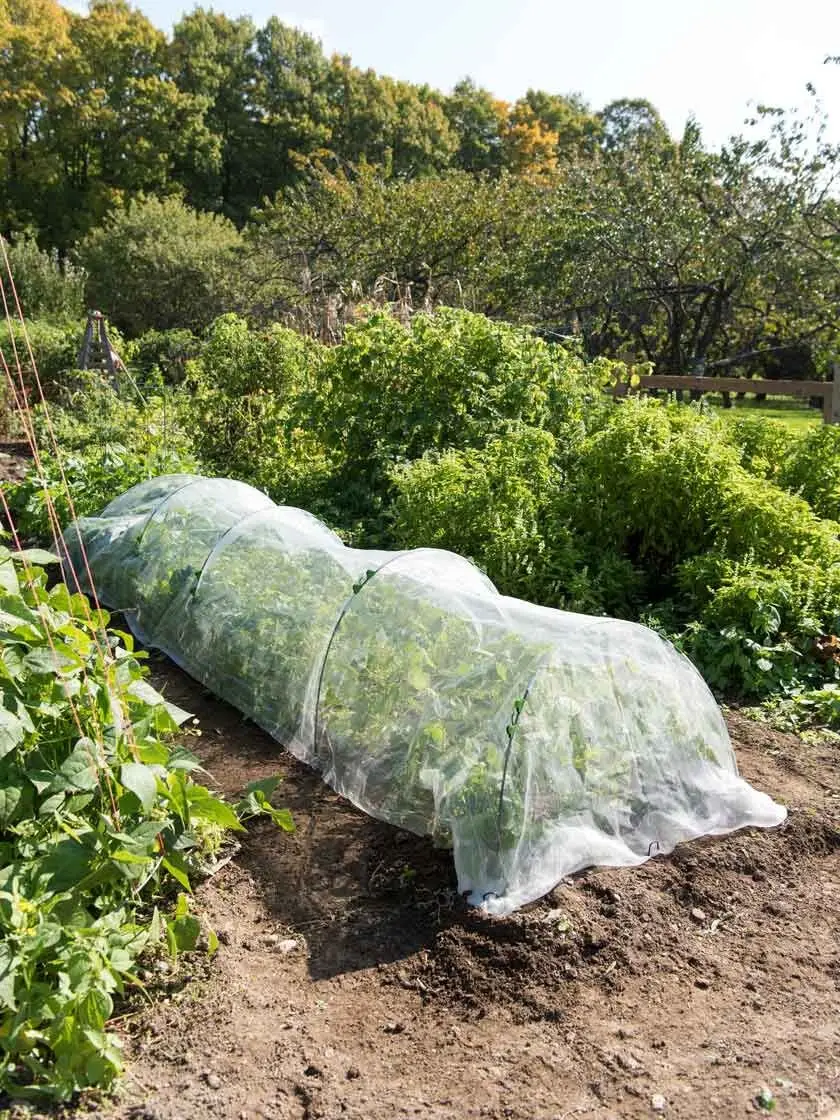Hoop houses are one of the many structures utilized to grow plants earlier in the spring and later in the fall. Also known as ‘low tunnels,’ they are usually constructed of bent PVC or steel pipes and can be positioned over raised beds or directly over row crops growing in the ground. The hoops are covered with 4 – 6 mm polyethylene sheeting attached to the pipes. They can extend the fall growing season by between 6 – 8 weeks and also allow for earlier direct seeding of certain spring crops.
Supplies for a 5 ½’ x 6 ½’ size hoop:
- (6) 5’ foot long PVC pipes at ½” inch diameter
- (2) 36” inch long PVC pipes at ½” inch diameter
- (6) 2’ foot long rebar at ½” inch diameter
- (1) cross fitting Charlotte pipe at ½” inch diameter
- (2) “T” Charlotte pipes at ½” inch diameter
- (6) spring clamps
- (1) roll of ~ 14 ½’ x 11 ½’ sheet of plastic greenhouse cover
Note: You may need to add more clamps to the frame as the weather dictates. Colorado is becoming an increasingly windy environment and wind is a hoop house’s arch nemesis.
Things to know:
- Hoop houses are a great fall season extension practice. As the weather cools, the plants accumulate sugars in their leaves to avoid freezing, leading to a ‘sweeter’ overall taste.
- Soil temperatures inside the hoop house are several degrees warmer than those outside, allowing for slow, but consistent growth.
- Hoop houses hold in moisture so with slower crop growth in late fall due to temperature changes and lower light intensities, crops require less supplemental watering.
- Weather and other challenges, including hail, early frosts, and insect damage are less of a problem with hoop houses.
- To capture more heat inside the growing area, place several black painted one-gallon water-filled milk jugs at various locations inside the hoop house. Heat gets absorbed during the day and released slowly at night, slightly raising the growing temperature.
- Utilize fall leaves as mulch around growing crops to provide extra insulation. Leaves add to the soil’s organic matter as they decompose promoting a healthier growing environment.
- If possible, place your structure in full sun, sheltered from prevailing winds, oriented toward the south. Additional straw bales can be placed along the north side of the structure for added insulation.
- Since heat will accumulate inside the house, the plastic covering should be rolled up on one end when daytime temperatures reach 60 degrees or higher. Ventilation is crucial to prevent plant leaves from ‘baking’ as interior house temperatures rise. Remember to lower the ‘flaps’ and re-secure them as evening approaches.

Prior to planting seeds or seedlings in the hoop house:
- Realize that such structures are best used for cold tolerant crops (more on this below), not to extend the growing season for main season crops such as tomatoes, peppers, eggplant, basil, beans, cucumbers, melon or summer and/or winter squash and pumpkins.
- Remove any weeds and spread an inch or so of plant-based compost (such as ‘A1 Organics EcoGro’) on top of the planting surface and lightly dig or cultivate into the top inch of soil.
- Water the planting area well prior to planting.
Other considerations:
- Denver’s first frost usually occurs early in October, so consider planting for season extension by the 2nd week of September.
- Choose cool season seed varieties (options listed below) that mature in the shortest period of time. Look at the back of seed packets for that information. Add 10 – 14 days to whatever time is listed under ‘days to harvest’ since lower levels of light in the fall and cooler temperatures increase the time for seeds to germinate and grow.
Cool Season Crops to consider:
- Seeds: Spinach, kale, radishes, beets, green onions, mustard greens, arugula, cilantro, parsley, ‘bok choy’ and ‘mesclun’ (mixed Asian greens with some hardy lettuce varieties), Egyptian ‘walking’ onions (special varieties with top setting small ‘bulblets’) are all good choices.
- Transplants: 6 – 8 week old transplants of swiss chard, collard greens, broccoli, cabbage, cauliflower and brussel sprouts can also be planted. Always choose varieties that mature in the shortest period of time.
- Late summer planted carrots can be successfully overwintered in hoop houses by heavily mulching them with leaves. Their roots will accumulate sugars and be easier to harvest during the winter with the protection of the leaf mulch.
- Salad greens such as kale, mustard greens, spinach, arugula and lettuce mixes, in addition to ‘bok choy’ are best maintained by frequently harvesting outer leaves to promote growth.
Spring usage of hoop houses:
- Although hoop houses are best utilized for season extension in the fall, they can also be used to ‘jump start’ the spring growing season.
- With daylight hours increasing and the angle of the sun rising, many of the same salad greens planted in the fall can be directly-seeded in the hoop house beginning in mid-February, with spinach, Asian green mixes, green onions and radish being the first to be planted. Practice ‘succession planting,’ sowing small quantities of seeds every 2 weeks or so to promote staggered maturity.
- If you are starting your own transplants of cool season crops in the broccoli family, they can be started inside in mid-February and placed in pots outside in the hoop house as 6-8 week old transplants.
- Warm season transplants, such as tomatoes, peppers, eggplants and basil can spend their last few weeks in their starter pots in the hoop house before you plant them in the garden to be exposed to stronger light intensities.
- Any transplant into the hoop house needs to be ‘hardened’ off for 7 days or so prior to its eventual planting in the outside garden. During this process, plants are gradually exposed to increasing levels of light intensity, wind and dry air conditions so they can adapt well to Colorado growing conditions. Over the space of a week, remove them from their sheltered ‘house,’ and protect them from strong winds by placing them near a house or other structure. Gradually increase their outside exposure by several hours each day, remembering to water their containers well each day if the soil dries out.



